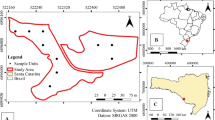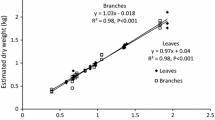Abstract
One of the characteristics of great relevance in the wood quality in Spanish coniferous forests due to growth conditions is the presence of corewood. This wood area presents properties and characteristics inferior to those in outerwood, which are more appropriate for certain uses. In plantations with short rotations, the percentage of juvenile timber is higher, and the profitability of the wood can be affected due to its unsuitability for high added value applications, such as structural. This work focuses on determining whether the use of models of current annual increase in height can provide suitable estimations of the year or transition zone between corewood and outerwood. This knowledge will contribute to analyze the expected yield of quality wood. The material studied is from Pinus sylvestris L. (Scots pine) and Pinus nigra Arnold subsp. nigra (black pine) pure stands. Densitometry results showed that the corewood–outerwood transition year could not be predicted by tree height functions.



Similar content being viewed by others
References
AEMET (2017) Climatic data provided by the State Meteorological Agency (AEMET), Ministry of Agriculture, Food and Environment, Spain
Bendtsen BA, Senft J (1986) Mechanical and anatomical properties in individual growth rings of plantation-grown eastern cottonwood and loblolly pine. Wood Fiber Sci 18:23–38
Burdon RD, Kibblewhite RP, Walker JCF, Mcgraw RA, Evans R, Cown DJ (2004) Juvenile versus mature wood: a new concept, orthogonal to corewood versus outerwood, with special reference to Pinus radiata and Pinus taeda. For. Sci 50:399–415
Cañadas MN (2000) Pinus pinea L. en el Sistema Central (valles del Tiétar y del Alberche): desarrollo de un modelo de crecimiento y producción de piña. Tesis doctoral. Universidad Politécnica de Madrid, Madrid
Fernandez MP, Cornejo B (2016) Is the first flowering event and corresponding maturity phase in trees related to radial wood density changes? Trees-Struct Funct 30:859–870. https://doi.org/10.1007/s00468-015-1326-9
Gapare WJ, Wu HX, Abarquez A (2006) Genetic control of the time of transition from juvenile to mature wood in Pinus radiata D. Don. Ann For Sci 63:871–878. https://doi.org/10.1051/forest:2006070
García Güemes C (1999) Modelo de simulación selvícola para Pinus pinea L. en la provincia de Valladolid. Tesis Doctoral. Universidad Politécnica de Madrid, Madrid
Goudie JW, Di Lucca CM (2004) Modelling the relationship between crown morphology and wood characteristics of coastal western hemlock in British Columbia. In: Fourth Workshop on the connection between silviculture and wood quality through modelling approaches and simulation software (IUFRO WPS5.01-04), Nancy, France
Hermoso E, Fernández-Golfín JI, Díez MR (2003) Mechanical characterization of timber according to European standards from Spanish provenances of Scots Pine. For Syst 12:103–110. https://doi.org/10.5424/1082
Ilic J, Northway R, Pongracic S (2003) Juvenile Wood Characteristics, Effects and Identification. CSIRO Forestry and Forest Products. Forest and Wood Products Research and Development Corporation, Australia FWPRDC Report PN02.1907, 23
Ivković M, Gapare WJ, Abarquez A, Ilic J, Powell MB, Wu HX (2009) Prediction of wood stiffness, strength, and shrinkage in juvenile wood of radiata pine. Wood Sci Technol 43:237–257. https://doi.org/10.1007/s00226-008-0232-3
Kučera B (1994) A hypothesis relating current annual height increment to juvenile wood formation in Norway Spruce. Wood Fiber Sci 26:152–167
Lachenbruch B, Moore JR, Evans R (2011) Radial variation in wood structure and function in woody plants, and hypotheses for its occurrence. In: Meinzer FC, Lachenbruch B, Dawson TE (eds) Size- and age-related changes in tree structure and function. Springer, Berlin, pp 121–164. https://doi.org/10.1007/978-94-007-1242-3_5
Larson PR (1969) Wood formation and the concept of wood quality. Yale University, New Haven, School of Forestry Bulletin no. 74, 54
Larson PR, Kretschmann DE, Clark AI, Isebrands JG (2001) Formation and properties of juvenile wood in southern pines: a synopsis. USDA, Forest Service General Technical Report, FPL-GTR-129, 42
Mansfield SD, Parish R, Goudie JW, Kang K-Y, Ott P (2007) The effects of crown ratio on the transition from juvenile to mature wood production in lodgepole pine in western Canada. Can J For Res 37:1450–1459. https://doi.org/10.1139/X06-299
Michajlov J (1952) Mathematische Formulierung des Gesetzes für Wachstum und Zuwachs der Waldbäurne und Bestände. Schweiz Z Forstwes 103(9/10):368–380
Montero G, Cañellas I, Ruíz-Peinado R (2001) Growth and yield models for Pinus halepensis Mill. Invest Agr Sist Recur For 10(1):179–201
Moore JR, Cown DJ (2017) Corewood (juvenile wood) and its impact on wood utilization. Curr For Rep 3(2):107–118. https://doi.org/10.1007/s40725-017-0055-2
Muggeo V (2008) Segmented: an R package to fit regression models with broken-line relationships. R News 8:20–25
R Core Team (2017) R: a language and environment for statistical computing. R Foundation for Statistical Computing, Vienna, Austria. https://www.R-project.org/. Accessed 12 July 2019
Rodríguez E, Ortega M (2006) Tendencias radiales de la densidad y sus componentes en Pinus nigra Arn. de la Península Ibérica. Sist Recur For 15:120–133
Rojo A (1994) Crecimiento y producción de Pinus sylvestris L. en la Sierra de Guadarrama. Tesis Doctoral. Universidad Politécnica de Madrid
Rojo A, Montero G (1996) El pino silvestre en la Sierra de Guadarrama. M.A.P.A, Madrid
Sauter UH, Mutz R, Munro BD (1999) Determining juvenile-mature wood transition in Scots pine using latewood density. Wood Fiber Sci 31:416–425
Zobel BJ, Sprague JR (1998) Juvenile wood in forest trees. Springer series in wood science. Springer, Berlin
Acknowledgements
This study has been carried out with the support of the Ministry of Economy and Competitivity of the Government of Spain through the Project RTA2014-00005-00-00, and the Training Program for Research Staff (FPI-INIA). We would like to thank to Enrique Garriga and Ramon García who helped on the field work, to Juan Carlos Cabrero who presented creative ways on how to proceed, to Eduardo Trobajo who did the micro-X-ray densitometry and to the carpenter Emilio Camacho who made the processing of the samples possible.
Author information
Authors and Affiliations
Corresponding author
Additional information
Communicated by Martina Meincken.
Publisher's Note
Springer Nature remains neutral with regard to jurisdictional claims in published maps and institutional affiliations.
Rights and permissions
About this article
Cite this article
Ruano, A., Ruiz-Peinado, R., Fernández-Golfín, J. et al. Height growth for assessing core–outerwood transition on Pinus sylvestris and Pinus nigra Spanish stands. Eur J Forest Res 139, 273–278 (2020). https://doi.org/10.1007/s10342-019-01231-0
Received:
Revised:
Accepted:
Published:
Issue Date:
DOI: https://doi.org/10.1007/s10342-019-01231-0




